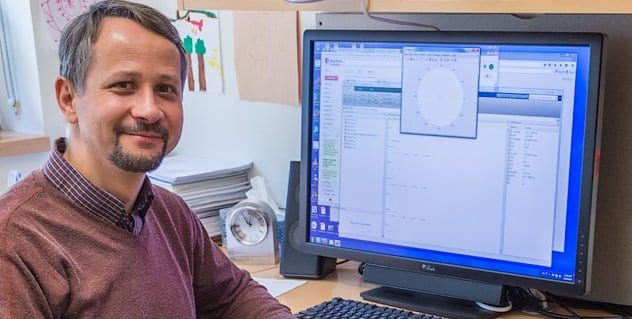By Daniel Dunaief
An especially hot July day can send hordes of people to Long Island beaches. A cooler July temperature, however, might encourage people to shop at a mall, catch a movie or stay at home and clean out clutter.
Similarly, genes in yeast respond to changes in temperature.
Gábor Balázsi, the Henry Laufer associate professor of physical and quantitative biology at Stony Brook University, recently published research in the Proceedings of the National Academy of Sciences on the effect of temperature changes on yeast genes.
“We are looking at single cells and at genetic systems and we can dissect and understand gene by gene with a high level of detail,” said Balázsi, who used synthetic genetic systems to allow him to dissect and understand how temperature affects these genes.
 Understanding the basic science of how genes in individual cells respond to temperature differences could have broad applications. In agriculture, farmers might need to know how genes or gene circuits that provide resistance to a pathogen or drought tolerance react when the temperature rises or falls.
Understanding the basic science of how genes in individual cells respond to temperature differences could have broad applications. In agriculture, farmers might need to know how genes or gene circuits that provide resistance to a pathogen or drought tolerance react when the temperature rises or falls.
Similarly, researchers using genetically designed biological solutions to environmental problems, like cleanups at toxic spills, would need to understand how a change in temperature can affect their systems.
Lingchong You, an associate professor of biomedical engineering at Duke University, believes the research is promising.
“Understanding how temperature will influence the dynamics of gene circuits is intrinsically interesting and could serve as a foundation for the future,” You said. Researchers “could potentially design gene circuits to program the cell such that the cell will somehow remember its experience with the fluctuating temperatures,” which could provide clues about the experience of the cell.
Balázsi suggested the goal of his work is to understand the robustness of human control over cells in nonstandard conditions.
While other researchers have explored the effects of gene expression for hundreds of genes at different temperatures, Balázsi looked more precisely at single genes and human-made synthetic gene circuits in individual cells. He discovered various effects by inserting a two-gene circuit into yeast.
At the whole-cell level when temperatures rise from 30°C to 38°C, some cells continued growing, albeit at a slower rate, while others stopped growing and started to consume their proteins.
For the second type of cells, changing temperatures can lead to cell death. If the temperature comes down to normal levels soon enough, however, researchers can rescue those cells.
“How this decision happens is a question that should be addressed in the future,” Balázsi said.
While the dilution of all proteins slows down, the chemical reactions in which they participate speed up at a higher temperature, much like children who become more active after receiving sugar at a birthday party.
At another level, certain individual molecules change their movement between conformations at a higher temperature. Proteins wiggle more between different folding conformations even if they don’t change composition. This affects their ability to bind DNA.
Balázsi said he is fortunate that he works through the Laufer Center for Physical and Quantitative Biology, which partly supported the work, where he was able to find a collaborator to do molecular dynamic simulations. Based on the pioneering experiments of postdoctoral fellow Daniel Charlebois, with help from undergraduate researcher Sylvia Marshall, the team collected data for abnormal behaviors of well-characterized synthetic gene circuits. They worked with Kevin Hauser, a former Stony Brook graduate research assistant, who explained how the altered conformational movements affected how the protein and cells behaved.
The way proteins fold and move between conformations determines what they do.

Photo from Gábor Balázsi
Taking his observations and experiments further, Balázsi found that proteins that were unbound to a small molecule didn’t experience a change in their conformation. When they were linked up, however, they demonstrated a new behavior when heated. This suggests that understanding the effects of temperature on these genetic systems requires an awareness of the proteins involved, as well as the state of their interaction with other molecules.
While Balázsi explored several ways temperature changes affect the yeast proteins, he acknowledged that other levels or forces might emerge that dictate the way these proteins change.
Additionally, temperature changes represent just one of many environmental factors that could control the way the genetic machinery of a cell changes. The pH, or acidity, of a system might also change a gene or group of genes.
A main overarching question remains as to how much basic chemical and physical changes combine with biological effects to give predictable, observable changes in the behaviors of genes and living cells.
Balázsi may test other cell types. So far, he’s only looked at yeast cells. He would also like to know the order in which the various levels of reactions — from the whole cell to the molecular level — occur.
He is interested in cancer research and possibly defense applications and would like to take a closer look at the way temperature or other environmental factors impact human disease processes and progression or think about their relevance for homeland security or biological solutions to renewable energy.
Balázsi recognizes that he and others in this field have numerous hurdles to overcome to find acceptable appreciation for the application of synthetic gene circuits.
“It’s not so simple to engineer these cells reliably,” he said. “Some roadblocks need to be eliminated to convince people it’s feasible and useful.”
Balázsi suggested that the field of virology might benefit from pursuing some of these research questions. Viruses move from the environment or even from other hosts into humans. Avian influenza, for example, can begin inside a bird and wind up affecting people. These viruses “might have different expression patterns in birds versus humans,” he said.
Ultimately, he added, this kind of scientific pursuit is “multipronged and the applications are numerous.”





